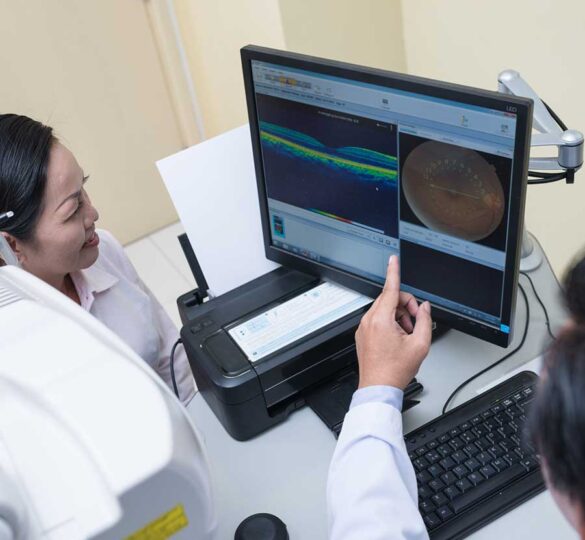Understand Your Glaucoma Diagnosis
The diagnosis of glaucoma is made when your eye doctor notices a particular type of damage in the optic nerve known as cupping. This diagnostic finding can occur with or without high intraocular pressure.

A normal intraocular pressure (IOP) ranges between 10 and 21 mmHg (millimeters of mercury, a measurement of pressure). While it is more likely that you will have or develop glaucoma if your eye pressures are high, many people with high eye pressures never develop glaucoma. Furthermore, some people with glaucoma never have high eye pressures. Glaucoma with eye pressure in the normal range is known as normal-tension glaucoma.
Diagnostic Exams
During an exam, in addition to checking your eye pressure, your eye doctor may use drops to dilate the pupil to examine your optic nerve. Your doctor may also use a diagnostic machine such as the OCT, GDx or the HRT to visualize and assess damage to the optic nerve. This can sometimes show damage in eyes before it is suspected by the doctor’s examination.
If damage is severe enough, vision changes can be detected on a peripheral vision test known as a Visual Field Test. Often the patient won’t notice peripheral vision changes until there is significant vision loss. Once the glaucoma diagnosis is made either by optic nerve examination or visual field testing, treatment is initiated.
Treatment
Today the only treatments available are those which lower the intraocular pressure. Lowering eye pressure can be accomplished using medicines, laser, or surgery. Treatment needs to be carried out for life. Glaucoma can be controlled, but there is currently no cure.
When medication is chosen, eye drops are usually prescribed. Some of the drops need only be used once daily while some require twice or three times a day dosing.
The laser has been shown to be as effective a first treatment as eye drops. This is a simple, mostly painless, quick procedure that can control eye pressure for a period of up to 5 years in some patients.
Many surgeries are available and newer ones are being constantly developed and evaluated. Most of these are reserved for patients with more advanced glaucoma, but some newer surgeries are safe enough for use earlier in the disease.
Choice of treatment depends on many factors which are unique to each patient and should be discussed with your doctor. Correct treatment usually will protect against further vision loss.
Will I Go Blind?
When faced with a new diagnosis of glaucoma there is one question that is foremost in every patient’s mind: Will I go blind?
Fortunately for most patients the answer is no. Blindness does occur from glaucoma but it is a relatively rare occurrence. There are around 120,000 cases of blindness in the United States and 2.3 million cases of glaucoma. This represents about 5% of glaucoma patients. However, sight impairment is more common and occurs in around 10% of patients.
Loss of vision can occur even with the best treatment. Despite that sobering fact, correct treatment and follow-up will stabilize the vast majority of patients with glaucoma. A major factor in the treatment of your glaucoma is you. By correctly using your eye drops and being consistent in their use, a favorable outcome will be more likely.
Article by A. Sydney Williams, MD. Last reviewed and updated on June 18, 2024.

A. Sydney Williams, MD
Dr. Williams is a Board-certified ophthalmologist, glaucoma specialist and surgeon in private practice at the San Francisco Eye institute in San Francisco and San Mateo, CA. He is an Associate Clinical Professor at the University of California in San Francisco in the Department of Ophthalmology and past director of glaucoma service at Stanford University Hospital.